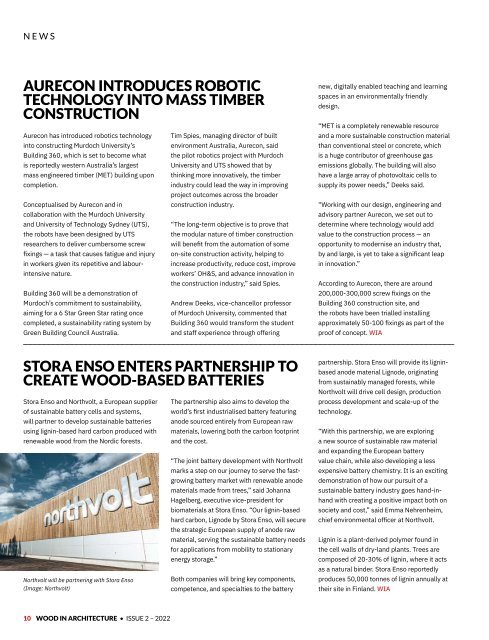Wood In Architecture Issue 2, 2022
First published in 2017, Wood in Architecture (WIA) is a bi-annual trade magazine devoted to the international timber construction sector. The newest addition to the Panels & Furniture Group of wood magazines, WIA features in-depth insights to the latest industry news, incredible projects and leading trade events. WIA is an advocate for timber as a material of choice for today’s built environment, and is the perfect source of inspiration for architects, builders, engineers and interior designers across the globe.
First published in 2017, Wood in Architecture (WIA) is a bi-annual trade magazine devoted to the international timber construction sector. The newest addition to the Panels & Furniture Group of wood magazines, WIA features in-depth insights to the latest industry news, incredible projects and leading trade events. WIA is an advocate for timber as a material of choice for today’s built environment, and is the perfect source of inspiration for architects, builders, engineers and interior designers across the globe.
You also want an ePaper? Increase the reach of your titles
YUMPU automatically turns print PDFs into web optimized ePapers that Google loves.
NEWS<br />
AURECON INTRODUCES ROBOTIC<br />
TECHNOLOGY INTO MASS TIMBER<br />
CONSTRUCTION<br />
Aurecon has introduced robotics technology<br />
into constructing Murdoch University’s<br />
Building 360, which is set to become what<br />
is reportedly western Australia’s largest<br />
mass engineered timber (MET) building upon<br />
completion.<br />
Conceptualised by Aurecon and in<br />
collaboration with the Murdoch University<br />
and University of Technology Sydney (UTS),<br />
the robots have been designed by UTS<br />
researchers to deliver cumbersome screw<br />
fixings — a task that causes fatigue and injury<br />
in workers given its repetitive and labourintensive<br />
nature.<br />
Building 360 will be a demonstration of<br />
Murdoch’s commitment to sustainability,<br />
aiming for a 6 Star Green Star rating once<br />
completed, a sustainability rating system by<br />
Green Building Council Australia.<br />
Tim Spies, managing director of built<br />
environment Australia, Aurecon, said<br />
the pilot robotics project with Murdoch<br />
University and UTS showed that by<br />
thinking more innovatively, the timber<br />
industry could lead the way in improving<br />
project outcomes across the broader<br />
construction industry.<br />
“The long-term objective is to prove that<br />
the modular nature of timber construction<br />
will benefit from the automation of some<br />
on-site construction activity, helping to<br />
increase productivity, reduce cost, improve<br />
workers’ OH&S, and advance innovation in<br />
the construction industry,” said Spies.<br />
Andrew Deeks, vice-chancellor professor<br />
of Murdoch University, commented that<br />
Building 360 would transform the student<br />
and staff experience through offering<br />
new, digitally enabled teaching and learning<br />
spaces in an environmentally friendly<br />
design.<br />
“MET is a completely renewable resource<br />
and a more sustainable construction material<br />
than conventional steel or concrete, which<br />
is a huge contributor of greenhouse gas<br />
emissions globally. The building will also<br />
have a large array of photovoltaic cells to<br />
supply its power needs,” Deeks said.<br />
“Working with our design, engineering and<br />
advisory partner Aurecon, we set out to<br />
determine where technology would add<br />
value to the construction process — an<br />
opportunity to modernise an industry that,<br />
by and large, is yet to take a significant leap<br />
in innovation.”<br />
According to Aurecon, there are around<br />
200,000-300,000 screw fixings on the<br />
Building 360 construction site, and<br />
the robots have been trialled installing<br />
approximately 50-100 fixings as part of the<br />
proof of concept. WIA<br />
STORA ENSO ENTERS PARTNERSHIP TO<br />
CREATE WOOD-BASED BATTERIES<br />
Stora Enso and Northvolt, a European supplier<br />
of sustainable battery cells and systems,<br />
will partner to develop sustainable batteries<br />
using lignin-based hard carbon produced with<br />
renewable wood from the Nordic forests.<br />
Northvolt will be partnering with Stora Enso<br />
(Image: Northvolt)<br />
The partnership also aims to develop the<br />
world’s first industrialised battery featuring<br />
anode sourced entirely from European raw<br />
materials, lowering both the carbon footprint<br />
and the cost.<br />
“The joint battery development with Northvolt<br />
marks a step on our journey to serve the fastgrowing<br />
battery market with renewable anode<br />
materials made from trees,” said Johanna<br />
Hagelberg, executive vice-president for<br />
biomaterials at Stora Enso. “Our lignin-based<br />
hard carbon, Lignode by Stora Enso, will secure<br />
the strategic European supply of anode raw<br />
material, serving the sustainable battery needs<br />
for applications from mobility to stationary<br />
energy storage.”<br />
Both companies will bring key components,<br />
competence, and specialties to the battery<br />
partnership. Stora Enso will provide its ligninbased<br />
anode material Lignode, originating<br />
from sustainably managed forests, while<br />
Northvolt will drive cell design, production<br />
process development and scale-up of the<br />
technology.<br />
“With this partnership, we are exploring<br />
a new source of sustainable raw material<br />
and expanding the European battery<br />
value chain, while also developing a less<br />
expensive battery chemistry. It is an exciting<br />
demonstration of how our pursuit of a<br />
sustainable battery industry goes hand-inhand<br />
with creating a positive impact both on<br />
society and cost,” said Emma Nehrenheim,<br />
chief environmental officer at Northvolt.<br />
Lignin is a plant-derived polymer found in<br />
the cell walls of dry-land plants. Trees are<br />
composed of 20-30% of lignin, where it acts<br />
as a natural binder. Stora Enso reportedly<br />
produces 50,000 tonnes of lignin annually at<br />
their site in Finland. WIA<br />
10 WOOD IN ARCHITECTURE • ISSUE 2 – <strong>2022</strong>


















